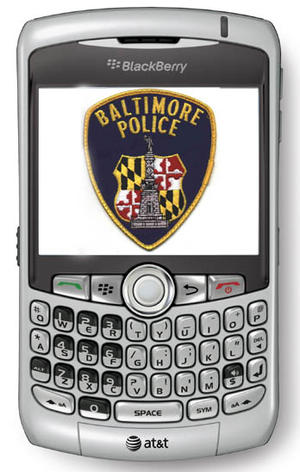Hi-tech, wireless policing works
There are 640,000 people living in Baltimore, and the Baltimore Police Department has 3,000 officers to protect them; to make the officers more mobile and flexible, the department equipped them with BlackBerry smartphones; the department toughened the smartphones, added an extra battery, and built clever software that lets officers use the phones for everything they once could do only with a laptop or via a dispatcher

Baltimore P.D. BlackBerry smartphone // Source: crackberry.com
Baltimore’s police department is one of the most famous in the United States thanks to that fine TV show, “The Wire.” Some critics say it is the best series ever made. It is gritty and superbly acted. Its characters personify their calling as “policeese” offices.
Times Lives’s Toby Shapshak writes that Cult figure and protagonist Detective James “Jimmy” McNulty and Baltimore’s finest bring down some of the biggest (fictional) criminals, drug dealers, and assorted hoodlums with the craftiest detective work.
The real-life police department has its own challenges, and has turned to some nifty technology to solve its problems. The Baltimore Police Department oversees a population of 640,000 with just more than 3,000 officers, but the technology they used — laptops and radios hardwired into their cars — was keeping them vehicle-bound.
“In the last 15 years in domestic law enforcement, we’ve trained cops to be close to or in their vehicles,” says Baltimore police commissioner Frederick H Bealefield III. “We’ve made the vehicle their mobile office. Except that now they don’t leave the office.”
To change this car-bound detective service to a faster and more efficient one, the department turned to BlackBerry smartphones. This has toughened them, added an extra battery and built clever software that lets officers use the phones for everything they once could do only with a laptop or via a dispatcher.
The combination, called Side Partner, becomes “an all-in-one tool for communications, criminal database access, zero-ing in on GPS locations, video and photography”, says Gayle Guilford, director of management information systems for the department. One application is InterActPocketCop, which lets the officers access the U.S. criminal justice database systems.
“While on a scene, without a dispatcher’s help, an officer can run a licence plate, look up a suspect’s name, and receive their criminal record and a current mugshot,” says Guilford.
The ability to access information directly has on its own helped tremendously to speed up the process, and saved a lot of time for officers and dispatchers.
“I no longer have to wait for the dispatcher to give me a person’s history,” says Sergeant Sheree Briscoe. “I can run that information while someone is in front of me, or even before I knock on a door. Having a BlackBerry smartphone means I’m spending less time trying to figure out who’s in my presence. I get more timely intelligence so I can quickly identify if I’m in a high-risk situation.” When the background check is done so quickly and a person is ruled out as a possible suspect, there is also a benefit for Baltimore’s citizens.
“It can leave people with a positive experience with a police officer because they’re not being held up as long,” she says.
Shapshak writes that the BlackBerry’s built-in GPS and camera capacities have other benefits too. The commander on duty can track where officers are at any time, and is able to direct them to areas where they are needed, especially for crowd control. It’s also helpful to use as a locator when the officer’s whereabouts are unknown, or he or she may be missing.
“Being able to tell where an officer last transmitted helps us find their most recently known location and means we might be able to get help to them faster,” says Guilford.
Baltimore police use the camera and video capacities to record what they see and use it as evidence in court . “Side Partner and the BlackBerry smartphone helps us achieve what our commissioner wanted - more officers out of cars and in the community, interacting with people on the street in a way that’s both safe and has the information they need,” Guilford says.
The department is running double the number of warrants from a year ago, without using laptops, radio calls and dispatchers, while each officer is saving thirty minutes a day not waiting for the dispatchers’ reply.
Earlier this year, Guilford and her team’s solution won the 2010 Wireless Leadership Awards, sponsored by BlackBerry’s maker Research in Motion, for Innovation in the Public Sector.
